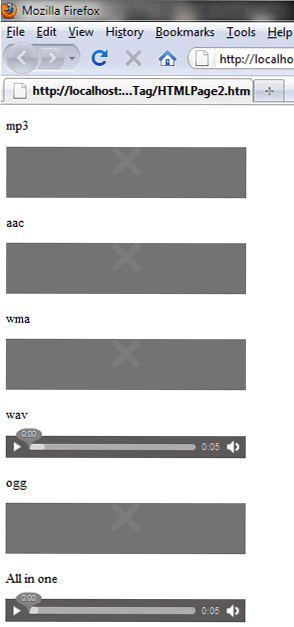

In the code, the src attribute refers to the URL of the audio file, and the controls attribute adds a control panel (launch button, scroll bar, volume regulator).

The audio element can be controlled with HTML or Javascript and styled with CSS. In HTML5, we can embed audio files using the tag, and there is no need to connect third-party plugins. The file was played while the page was viewed, and the user couldn’t mute the sound.
Html5 audio tag how to#
How to Add Audio on the Web Pageīefore HTML5, audio files were added to the page by integrating background sound with the help of tag. The element is used to embed audio files to a web page, and the element is used to embed a video. Later, HTML5 specification introduced such features with the and elements. Plugin-based technologies became popular for handling such content, but they had many problems, including not working well with HTML/ CSS features, security and accessibility issues.
Html5 audio tag download#
SVG Intro SVG in HTML5 SVG Rectangle SVG Circle SVG Ellipse SVG Line SVG Polygon SVG Polyline SVG Path SVG Text SVG Stroking SVG Filters Intro SVG Blur Effects SVG Drop Shadows SVG Linear SVG Radial SVG Referenceĭeprecated Attributes HTML Class Attribute HTML id AttributeĪlt async accept content contenteditable controls coords disabled download draggable autocomplete autofocus defer dir colspan accesskey action autoplay checked accept-charsetĮarlier, native web technologies such as HTML didn't allow embedding video and audio on the Web.
Html5 audio tag iso#
HTML5 Introduction HTML5 Tags Semantic Elements Audio & Video HTML5 Browser Support HTML5 MigrationĬharacter Sets ASCII ISO-8859-1 ISO Language Codes UTF-8 Encoding HTML Entities Keyboard Shortcuts HTTP Methods HTML Images HTTP Status Messages MIME-Types Table of HTML Tags XHTML HTML URLĭeprecated Tags HTML Global Attributes Event Attributes - Ĭanvas Intro Canvas Drawing Canvas Coordinates Canvas Gradients Canvas Text Canvas Images Canvas Reference Cordova is a solid technology, the audio feature has been tested for years so it’s a robust choice.HTML Introduction Editors & Tools HTML Elements HTML Basic Tags HTML Attributes HTML Headings HTML Formatting HTML Links HTML Lists HTML Colors HTML Comments HTML Tables HTML Blocks HTML Scripts HTML Styles - CSS HTML File Paths HTML Computercode If not, you can use the Ionic Native Audio plugin because it’s built on Cordova which uses the Native Components of the device. If you are confident that your users will have top-notch devices, you can go with HTML5 Audio. The only task you should worry about is unloading the tracks at the right place and the right moment, here it's done in the ngOnDestroy method, however, depending of your application it could be done somewhere else. ConclusionĪdding some sounds in an Ionic application is quite easy and it should be! The ngOnDestroy hook will clean up by summoning the unload method with the corresponding identifier. If we just want the sound like a background music for example, it's possible to remove the controls attribute, add a reference to the tag: Īnd move to the home.ts file to finalize the work: import In this example the controls attribute adds more HTML Elements to allow the user to play, pause, move forward, etc. The audio tag is a standard, it possesses a lot of features you can harness (documentation here). This is the simplest way to create an audio player: the HTML5 Element. Your browser does not support the audio element.
Html5 audio tag install#
Starting from scratch: npm install -g ionic cordova start myApp blankĪnticipating here and adding Cordova for the second part of this tutorial. Note that it's also possible to use a remote url instead of a local file (in this case the file might take longer to load, you should add the preload attribute to the audio tag we will use a bit further). My tracks will be located in the src/assets/audio directory: As you already know, Ionic allows us to use HTML5 to build mobile applications, so we can use the HTML5 features! HTML5 audio

Thanks to the HTML5 audio tag it's possible to create an audio player for a web application with four lines of code. Then came HTML5 and people started wondering why they could watch their videos without crashes🤔. just kidding.īack in the days Flash was very helpful, we were able to make animations, audio players and so much more! This is what we are going to use because it's the best technology in the world. Adding Sounds using HTML5 and Native Audio in Ionic


 0 kommentar(er)
0 kommentar(er)
